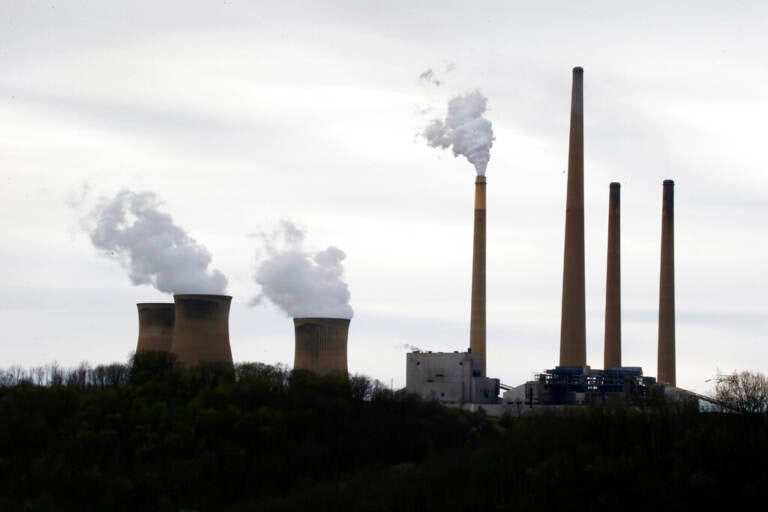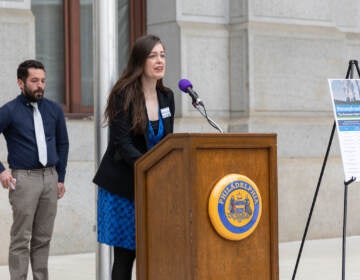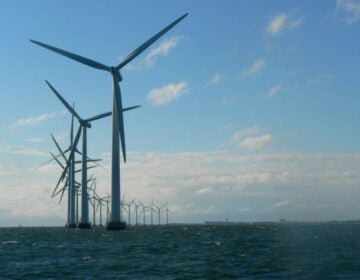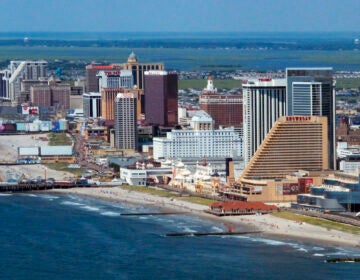How EPA’s proposed power plant rules could impact Pennsylvania
The proposal comes as the dangerous impacts of human-caused climate change become increasingly clear.

File photo: This photo taken May 5, 2014 shows the stacks of the Homer City Generating Station in Homer City, Pa. (AP Photo/Keith Srakocic)
This story is part of the WHYY News Climate Desk, bringing you news and solutions for our changing region.
From the Poconos to the Jersey Shore to the mouth of the Delaware Bay, what do you want to know about climate change? What would you like us to cover? Get in touch.
A new proposal by the EPA to limit planet-warming carbon emissions from power plants is expected to cut pollution in Pennsylvania, the state with the fourth-highest energy-related emissions in the country.
“It’s transformative in terms of reducing carbon emissions,” said Joseph Minott, executive director of the Philadelphia-based Clean Air Council.
The proposal comes as the dangerous impacts of human-caused climate change become increasingly clear. Scientists say there is still time to limit future warming by rapidly slashing the use of fossil fuels.
“We’re already seeing the consequences of excessive temperature rise, in the heat emergencies that we’ve seen in Philadelphia last year,” said Mathy Stanislaus, director of The Environmental Collaboratory at Drexel University. “This is a major target to reduce the consequence of … temperature-increasing gasses.”
The proposal still needs to go through public comment and is expected to face legal challenges. If finalized, it would require many natural gas and coal-fired power plants to nearly eliminate their emissions in a little over a decade. It sets different standards based on the fuel plants use, how much plants operate, and when they plan to retire. Facilities are expected to use carbon capture technology or hydrogen to meet the proposed limits. Some could even close as a result of the rules.
The proposed regulation “sets forth emission reduction targets for power plants. It then leaves that up to the power plant operators regarding how to achieve those targets,” Stanislaus said. “The specific strategies each power plant [uses] is going to depend upon the current status of the power plant, its current emissions, and what makes most economic sense.”
The EPA estimates it would prevent the release of 617 million metric tons of total carbon dioxide through 2042 — or the annual emissions of around half the cars in the United States.
Coal and natural gas-fired power plants in Pennsylvania are the state’s largest individual industrial climate polluters, according to an analysis of 2021 EPA emissions data released by the environmental advocacy group PennEnvironment last week. More than a quarter of the state’s total greenhouse gas emissions come from producing electricity.
“Given the sheer … percent of Pennsylvania electricity that’s generated by fossil fuels, this rule will have a significant impact in Pennsylvania,” said Robert Routh, an attorney at the Clean Air Council.
The EPA proposal would likely have more impact on Pennsylvania’s big natural gas-burning plants than on its big coal-burning plants, said Eric Schaeffer, executive director of the nonprofit Environmental Integrity Project and former director of EPA’s Office of Civil Enforcement.
That’s because at least five of the six coal-burning plants that EPA data show emitted the most carbon emissions in Pennsylvania in 2022 are already scheduled to retire or stop using coal by 2028. These include the Conemaugh, Keystone, and Brunner Island plants, which plan to stop burning coal by 2028, the Montour plant, which plans to transition away from coal by 2025, and the Homer City coal plant, which plans to retire this year.
“This new power plant rule with additional limits on greenhouse gas emissions won’t kick in until after 2030,” Schaeffer said. “The plants are, on their own, on the way out before then.”
For existing natural gas-fired power plants, the proposal would only regulate those that can churn out more than 300 megawatts of power and operate at more than 50% capacity.
Pennsylvania appears to have dozens of natural gas-fired power plants below the 300 megawatt capacity threshold, according to the state Public Utility Commission’s latest report on Pennsylvania electric generation capacity.
“We’re glad to see this proposal and urge the EPA to extend it to more power plants to tackle the climate crisis, protect our health, and slash pollution that harms our communities,” said PennEnvironment’s Flora Cardoni in a statement Thursday.
The EPA is seeking comments on how to regulate smaller plants not covered by the proposal.
In addition to curbing planet-warming greenhouse gas emissions, the proposal is expected to improve the health of communities near fossil fuel-fired power plants, by reducing unhealthy local air pollution. The EPA says the proposal would prevent 1,300 premature deaths nationwide in 2030 alone.
But Pennsylvania would likely experience only a “slight improvement” in public health from the proposed regulations, said Shannon Capps, a Drexel University professor who specializes in air quality modeling and reviewed the EPA’s regulatory impact analysis.
Reductions in fine particulate pollution and ground-level ozone in the state in 2030 as a result of the proposed limits would be greatest in southwestern Pennsylvania, based on the EPA’s modeling, but would be at most around 1% of the predicted annual average levels of those pollutants that year, Capps said.
Reducing these unhealthy pollutants is “not the aim of this rule,” Capps said. “So these are kind of bonus points, if you want to look at it that way.”
The EPA proposal would likely complement the Regional Greenhouse Gas Initiative (RGGI), a cap-and-trade program which former Gov. Tom Wolf attempted to have Pennsylvania join, said Clean Air Council’s Routh. The regulation allowing Pennsylvania to join the program is on hold due to a court challenge.
“RGGI will create market conditions that incentivize cleaner generation in Pennsylvania, and that can only help with meeting the standards of performance that EPA ultimately finalizes,” Routh said.

Get daily updates from WHYY News!
WHYY is your source for fact-based, in-depth journalism and information. As a nonprofit organization, we rely on financial support from readers like you. Please give today.







